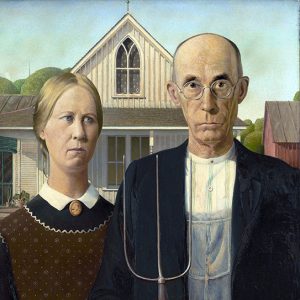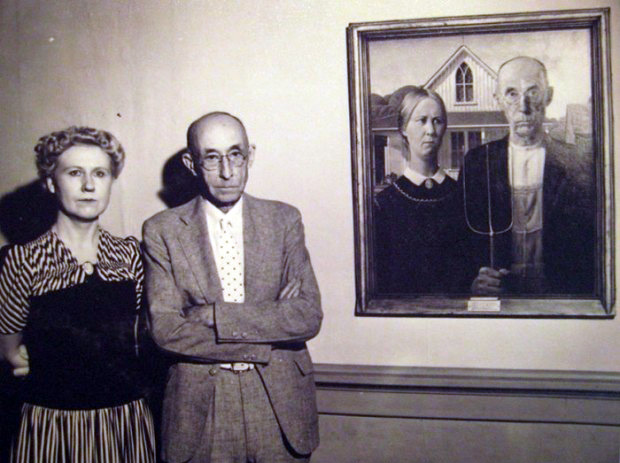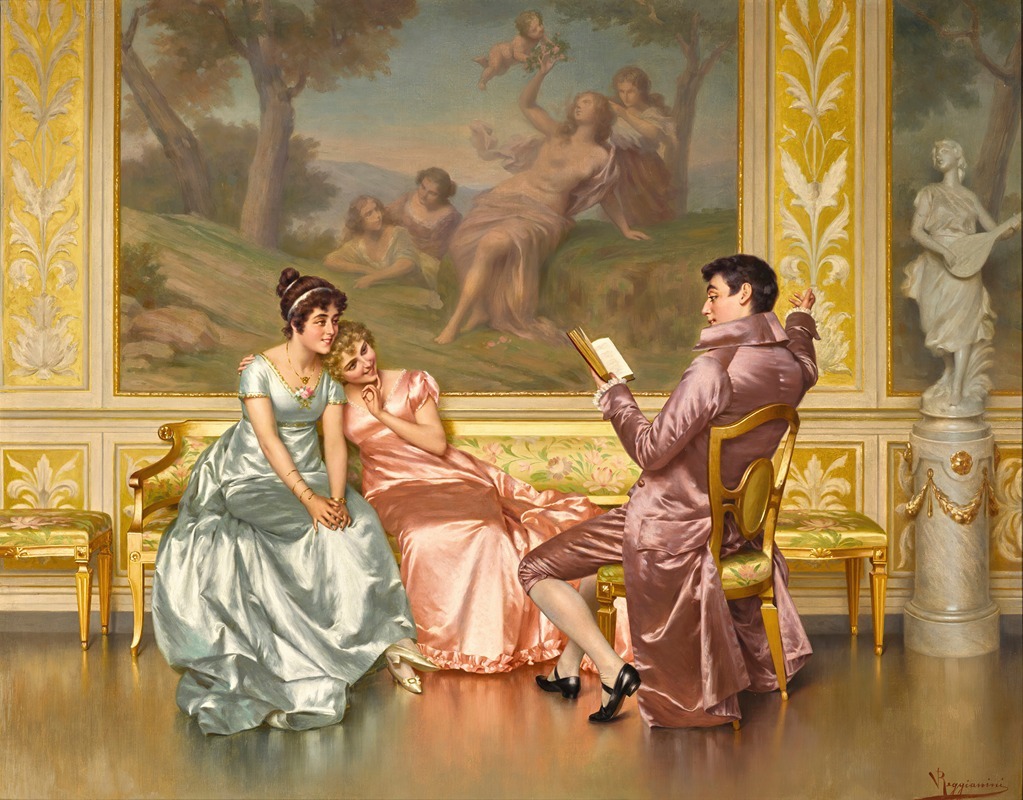Here’s what you came for: the people in American Gothic are real. Grant Wood used his sister, Nan Wood Graham, and his dentist, Dr. Byron H. McKeeby, as models for the famous farmer-and-daughter duo you know from the pitchfork portrait. You can even find a 1942 photo of them standing with the painting, reunited with their painted likenesses.
You see the pair in front of a small white house with a pointed Gothic window. Wood spotted that home—the Dibble House—in Eldon, Iowa, and built the entire idea around it. He said he imagined “American Gothic people with their faces stretched out long to go with this American Gothic house,” then dressed his models in period clothes to feel like old tintypes from a family album. He posed them separately, then composed the scene with crisp, Flemish-inspired precision that he loved after studying Northern Renaissance art.
You’ll find the painting at the Art Institute of Chicago, where it first showed in 1930, won a $300 prize, and made Wood famous overnight. The museum acquired it that year; its collection number is 1930.934, and it remains one of the most visited works there. If you want a quick label read: title American Gothic, artist Grant Wood (1891–1942), date 1930, medium oil on beaverboard, location Art Institute of Chicago.

You’re likely asking who the figures are meant to be. Wood framed them as archetypes, not portraits—rural Midwestern “types” he said he knew all his life. Most viewers read them as a farmer and his daughter, not a husband and wife, especially given the age gap between McKeeby and Nan in real life and the conservative dress that signals an older generation paired with a younger one. The pitchfork—originally a rake in early sketches—locks in the farmer identity and the defensive, upright stance that gives the picture its edge.
You might wonder why the faces look so severe. That choice was deliberate. Wood choreographed every element—the tight-lipped expressions, the rigid posture, the vertical rhythms of pitchfork tines, overalls, and house trim—to echo Northern Renaissance portraiture and to reflect a buttoned-up Midwestern ethos during hard times. He aimed for clarity and control: highly polished surfaces, fine detail, flat daylight, and exacting lines.
You’ll hear two stories about what the painting “means.” Many read it as satire, a send-up of small-town austerity; others see a sincere tribute to resilience and craft. Wood fueled both readings over time, but he emphasized respect: he intended “a positive statement about rural American values,” and he said he tried to make the models “more like themselves than they were in actual life”. That ambiguity helped the work lodge in American culture and stay there.
You want names and dates. Nan Wood Graham was born July 26, 1899, and died December 14, 1990; she was an artist and teacher in her own right and remained closely linked to the painting’s story. Dr. Byron H. McKeeby practiced in Iowa and posed at Wood’s request in Cedar Rapids; he’s widely identified as the man with the pitchfork that everyone recognizes today. Wood completed the painting in 1930, in the thick of the Regionalist art movement, alongside contemporaries like Thomas Hart Benton and John Steuart Curry.
You might search for the house. The American Gothic House still stands in Eldon, Iowa; its Carpenter Gothic window inspired the title and the whole setup. The house and a local center provide context, photos, and background materials, including images of the models visiting the painting in 1942.

You’ll also look for style notes. Wood blended Midwestern Regionalism with lessons from European art, particularly the Flemish masters’ polish and compositional rigor, and the cool clarity associated with New Objectivity. That mix—local subject, old-master technique—explains the image’s strange pull: modern and old, tender and tough, literal and symbolic at once.
You want to know why it endures. The image became a shorthand for Americana that people quote, parody, and repurpose endlessly, from political cartoons to ads to Halloween costumes. Its power comes from how open it is: you project your story onto their faces and the stiff, sunlit yard, then argue with yourself about what you just decided.
If you go see it, stand close and check the details: the crisp pitchfork tines, the neat stitching, the prim apron print, the glint on the window, the garden plants on the porch, and the tight interlock of house and figures that turns a simple scene into a locked frame. Step back, and watch the pair stare you down. You’ll feel the tension hold, and you’ll understand why this painting hasn’t left the conversation since 1930.

Hello art lovers. My name is Deepak Mehla, and I’m from Karnal, India. I enjoy reading stories about people’s struggles and how they overcome them. These motivational stories work like a source of energy for me.
Although Arttellers is completely different from my original vision, I, too, am going through a challenging phase in life. To keep myself busy and to hold on to hope, I share stories of artists with all of you. I believe these stories will give you a new direction, just as they inspire me.
Arttellers exists because I want to share how some people turn the work they love into their livelihood, and how choosing their passion leads them to success. I started Arttellers to keep my own hope alive and to help you discover people whose journeys might inspire you too.

